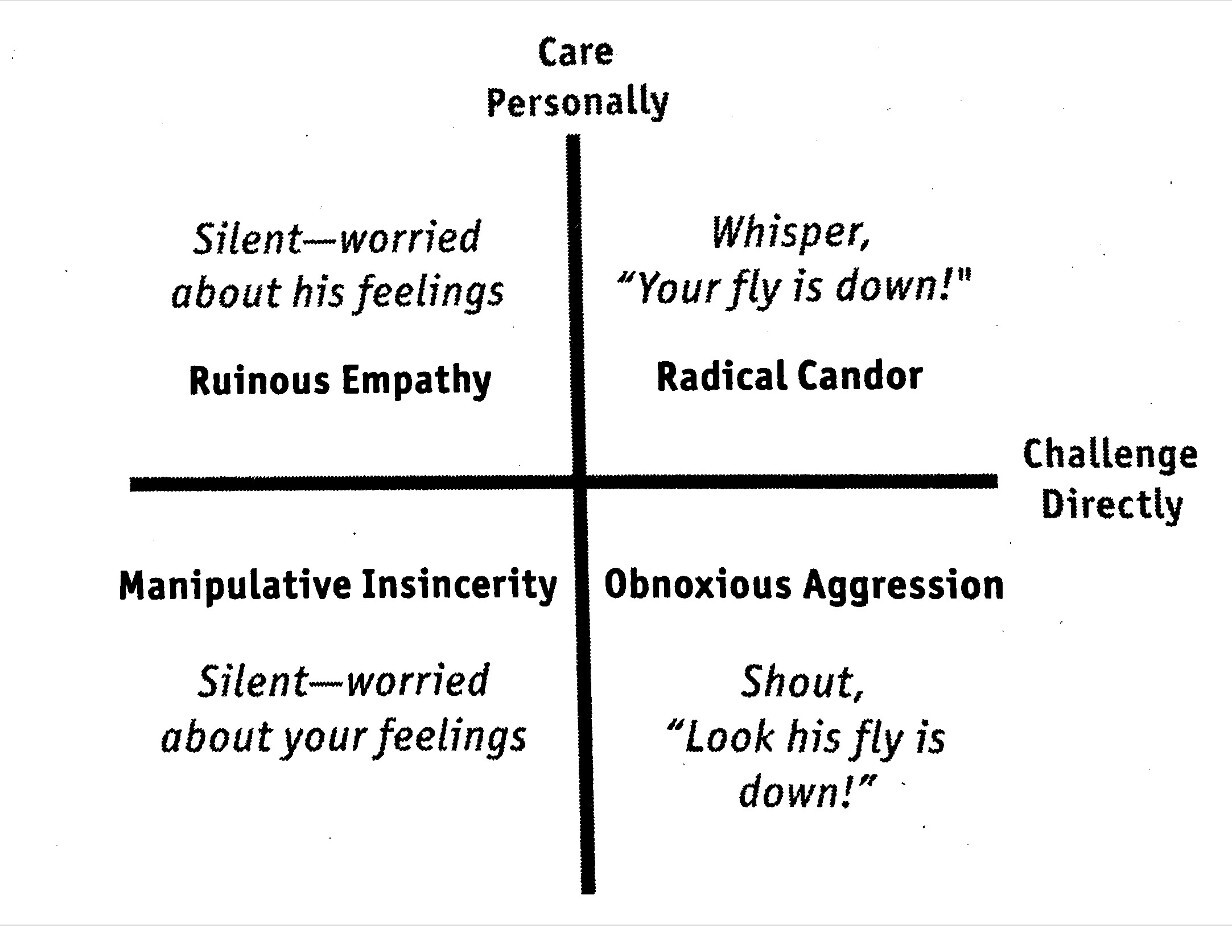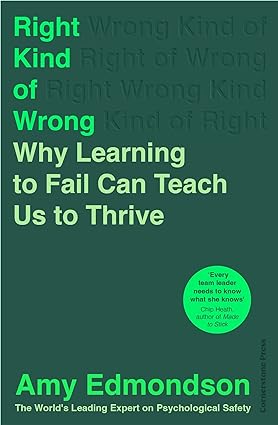
HomeRadical CandorBook SummaryRadical Candor
August 31, 2024
Radical Candor

- BinodShankar
- Book Summary
My top 25 points:
- There are two sides to Radical Candor. The first dimension is caring personally. The second dimension is challenging directly
- Caring personally is about finding time for real conversations; about getting to know each other at a human level; about learning what’s important to people; about sharing with one another what makes you want to get out of bed in the morning and go to work – and what has the opposite effect.
- Part of the reason why people fail to “care personally” is the injunction to “keep it professional”; but when we repress who we really are to earn a living, we become alienated. It makes us hate going to work and so instead we should bring our whole self to work and show some vulnerability to the people in our team.
- Challenging directly is about providing feedback right away and in a way that’s actionable and specific. It’s a way of showing that you care enough to want people to grow. Another key aspect of challenging directly is making it a two-way street- get feedback from others.
- There are four related leadership quadrants: Obnoxious Aggression, Manipulative Insincerity, Ruinous Empathy and Radical Candor.

- Obnoxious aggression is giving feedback without showing that you care. It is the second-best thing you can do, which explains the advantage that assholes seem to have in the world. People tend to prefer the challenging jerk to the too-nice softie.
- Manipulative insincerity is when you don’t care enough about the person to challenge them directly. In other words, you care more about yourself than the other person. e.g. ‘He’ll be happy if I tell him I liked his stupid presentation, and that will make my life easier in the long run, though I really need to find someone to replace him.’”
- Ruinous empathy is avoiding any and all tension in an effort to be nice. People might know they’ve done something wrong…but they don’t know exactly what, so they can’t do anything about it. Even worse, they might not know they’ve done anything wrong at all.
- Some advocate a praise-to-criticism ratio of 3:1, 5:1, or even 7:1. Others advocate the “feedback sandwich”—opening and closing with praise, sticking some criticism in between. Legendary Venture Capitalist Ben Horowitz calls this approach the “shit sandwich.” This might work with junior staff, but the average child sees through it just as clearly as an executive does.
- Superstars need to be challenged and given new opportunities to grow constantly. Superstars have a steep growth trajectory.
- Rock stars are solid as rock. …the rock stars love their work. They have found their groove. They don’t want the next job if it will take them away from their craft. Rock stars have a more gradual growth trajectory. But rock stars are just as important to a team’s performance as superstars.
- Stability is just as important as growth. Some roles may be better suited to a rock star because they require steadiness, accumulated knowledge, and an attention to detail that someone in a superstar phase might not have the focus or patience for.
- There’s nothing wrong with working hard to earn a paycheck that supports the life you want to lead. That has plenty of meaning. A wise man once said “Only about five percent of people have a real vocation in life, and they confuse the hell out of the rest of us”.
- Those who find work they can continue to love for five or ten or thirty years, even if it doesn’t lead to some sort of advancement, are damn lucky. And their teams and their bosses are lucky to have them. Kick-ass bosses never judge people doing great work as having “capped out.” They respect them.
- When management is the only path to higher compensation, the quality of management suffers, and the lives of the people who work for these reluctant managers become miserable.
- Make sure that you are seeing each person on your team with fresh eyes every day. People evolve, and so your relationships must evolve with them. Care personally; don’t put people in boxes and leave them there.
- Relationships are at the heart of the Radical Candor approach. The first one you need to investigate is your relationship with yourself. You can’t give a damn about others if you don’t give a damn about yourself.
- Relationships with your team come next. There can only be real trust when people feel free at work. One way is to spend time with people outside of work. Have a picnic, take a walk. Meet their families. Treat others how they would like to be treated (not how YOU like to be treated).
- If you lead a big team, you can’t have a close relationship with everybody. But the relationships you have with your direct reports will impact the relationships they have with their direct reports. The ripple effect will go a long way toward creating—or destroying—a positive culture.
- It’s brutally hard to tell people when they are screwing up. You don’t want to hurt anyone’s feelings. Plus, you’ve been told since you learned to talk, “If you don’t have anything nice to say, don’t say anything at all.” Now all of a sudden, it’s your job to say it. You’ve got to undo a lifetime of training. Management is hard.
- The way you ask for criticism and react when you get it goes a long way toward building trust—or destroying it.
- Gender politics can play a role in how guidance is given or received. Women are expected to be likable and don’t want to come off as abrasive. Men may pull punches when providing feedback to women.
- Applying Radical Candor can help you tap into your team’s motivation to avoid boredom and burnout. Have career conversations with them. Work on personal development plans. This is a great way to identify motivators, such as financial independence, environmentalism, working hard, attaining a leadership position.
- If you’re practicing Radical Candor, performance reviews shouldn’t be a surprise. Your team should know where they stand. But, for some people, that feedback they’re given might not really hit home until they see a low grade. The three conversations to spark connection and dig into motivation as part of your performance reviews: The Life Story, The Crazy Ass Dreams and the 18-month plan.
- If you have to choose between being liked and being effective, always choose to be effective.



